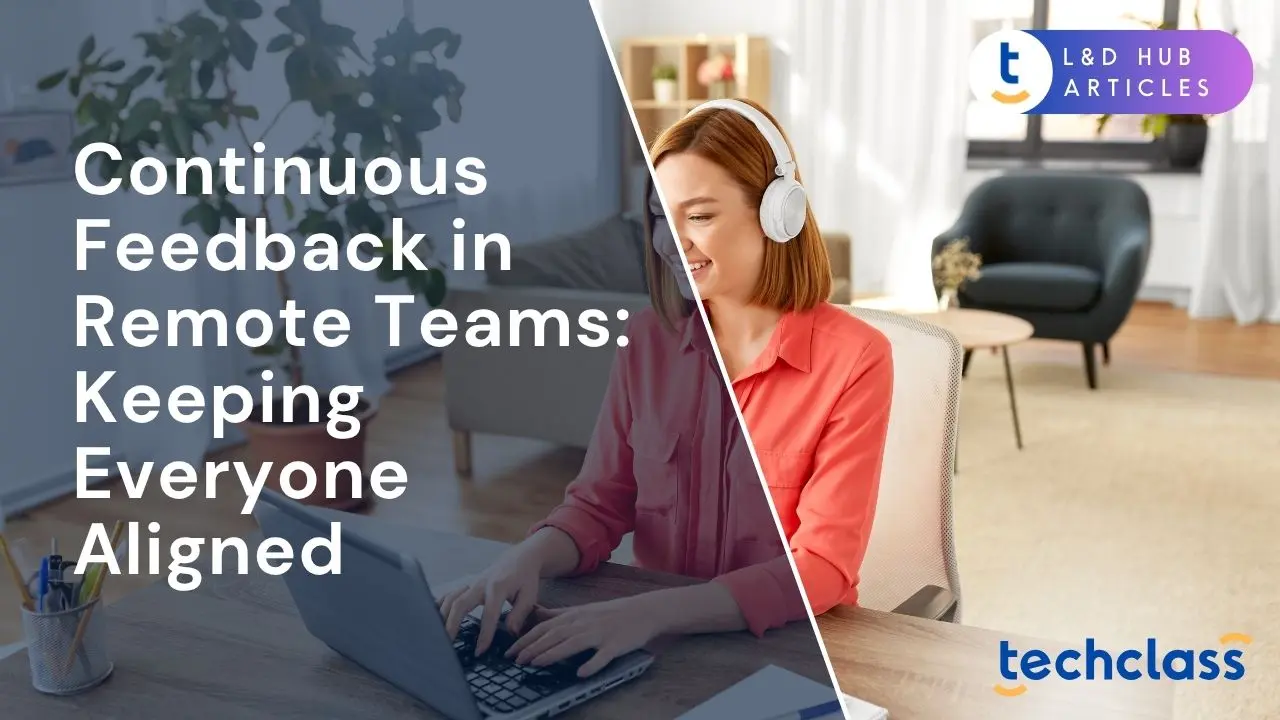Why Continuous Feedback is Essential for Remote Team Alignment
Remote work is now a mainstream reality for organizations of all sizes. Teams spread across cities or even continents must collaborate and stay productive without the benefit of in-person interactions. In this environment, maintaining alignment on goals, performance expectations, and company culture becomes a major challenge. Continuous feedback, the practice of providing frequent, real-time performance input and guidance, has emerged as a critical tool to keep remote team members connected and on track. Regular feedback conversations replace the informal chats and quick check-ins that co-located teams take for granted, ensuring that each employee knows how they are doing and how their work contributes to broader objectives. In fact, research shows a strong link between frequent feedback and employee engagement: a Gallup study found that about 80% of employees who received meaningful feedback in the past week were fully engaged at work, far higher engagement than those receiving infrequent input. Clearly, ongoing feedback is more than just nice-to-have, it’s essential for keeping dispersed teams unified, motivated, and performing at their best.
Managers and HR leaders are increasingly recognizing that traditional annual performance reviews are insufficient for a distributed workforce. By the time an annual review comes around, small problems may have snowballed and successes might be long forgotten. Continuous feedback helps bridge the distance between remote colleagues by creating an ongoing dialogue. Team members regularly hear what they’re doing well, where they can improve, and how their work aligns with team goals. This constant communication loop not only prevents misalignment, but also fosters trust and transparency. When feedback flows freely despite physical distance, remote employees feel noticed, supported, and part of a cohesive unit. The result is a team that can adapt quickly, correct course as needed, and stay aligned with the company’s mission, no matter where each member is working from.
What Is Continuous Feedback?
Continuous feedback refers to a management approach of providing employees with ongoing, frequent input on their performance and development, rather than waiting for infrequent formal reviews. Instead of a once-a-year evaluation, continuous feedback involves regular check-ins, weekly, biweekly, or monthly, where managers and team members discuss progress, clarify expectations, and exchange constructive insights. The focus is on real-time coaching and recognition. For example, if an employee successfully handles a client call or struggles with a project hurdle, their manager addresses it within days or weeks, not six months later. This timely feedback loop allows individuals to adjust their behaviors and improve continuously, fostering growth throughout the year.
Importantly, continuous feedback is a two-way street. Employees are encouraged to ask questions, seek guidance, and even provide upward feedback to managers. This creates a culture where feedback is viewed not as criticism reserved for special occasions, but as a normal part of work life. In a continuous feedback model, everyone is regularly exchanging ideas on how to do better. The approach encompasses praise and recognition for achievements, as well as constructive critique for improvement areas. Over time, this normalizes feedback and reduces the anxiety often associated with performance discussions. It also means there are no surprises, by the time a formal annual review or bonus discussion occurs, employees already know how they’ve been performing because feedback has been ongoing. Continuous feedback ultimately turns performance management into a continuous conversation, aligning it with the fast-paced and adaptive nature of modern work, especially in remote settings.
Challenges of Giving Feedback in Remote Teams
Providing effective feedback is challenging in any setting, but remote teams face unique obstacles that can hinder open communication and alignment. Understanding these challenges is the first step to overcoming them:
- Lack of Face-to-Face Cues: In a co-located office, managers can stop by someone’s desk for a quick chat or read body language during meetings. Remote work strips away those non-verbal cues and spontaneous moments. Without facial expressions or tone of voice in written messages, feedback can easily be misinterpreted. Team members might not fully grasp the intent or urgency behind comments, leading to confusion or defensiveness. The subtle feedback that happens informally in hallways or over lunch is largely missing, so remote managers must deliberately create moments for dialogue.
- Time Zone and Scheduling Hurdles: Remote teams often span multiple time zones, making it difficult to schedule real-time feedback conversations. A manager in New York may have a team member in Dubai; their working hours barely overlap. Important discussions can be delayed for days, causing feedback to lose immediacy. Teams might resort to written or asynchronous feedback out of necessity, but this can lack the interactivity of a live conversation. Coordinating regular one-on-one meetings that suit everyone’s schedule requires extra effort in a dispersed team.
- Technology Barriers: Even with today’s video conferencing and chat tools, technology can impede smooth communication. Poor internet connections, audio lags, or software glitches during a video call can disrupt the flow of a feedback session. Similarly, not everyone is equally comfortable with digital communication platforms, a manager might hesitate to give nuanced feedback via a chat message, or an employee might misread the tone of an email. Over-reliance on text communication in remote teams increases the chance of misunderstandings, especially for sensitive feedback topics.
- Reduced Informal Interaction: In an office, a lot of coaching and course-correcting happens organically. A team lead might notice an employee looking puzzled in a meeting and follow up immediately, or give a quick thumbs-up after observing a successful client interaction. In remote work, those informal feedback moments are rare. There are fewer “watercooler” chats or impromptu debriefs. This means performance issues might go unnoticed longer, and achievements might not be celebrated promptly. Remote employees can feel “in the dark” about how they’re doing without those casual signals from peers and managers.
- Cultural and Communication Differences: Remote teams are often globally distributed, which introduces differences in language and culture. A piece of feedback phrased bluntly might be acceptable in one culture but offensive in another. Likewise, some team members may be less inclined to speak up about issues due to cultural norms. Without careful attention, feedback can unintentionally alienate or upset colleagues from different backgrounds. The lack of context in remote communication can amplify these cultural misinterpretations.
- Silence and Hesitation: In virtual settings, some employees may hesitate to voice concerns or ask for feedback. A struggling team member might “suffer in silence” because they don’t see an easy opportunity to pull their manager aside for a private chat. Managers, on the other hand, may miss signs of frustration or burnout that would be more obvious in person. This can lead to small problems festering into big ones. A missed question or an unspoken confusion can snowball when the team is out of sync, hurting project timelines and team morale.
These challenges illustrate why simply transplanting office feedback practices into a remote model doesn’t always work. Remote leaders need to be intentional and proactive in how they give feedback. It’s crucial to compensate for the loss of physical proximity with clear communication, structured touchpoints, and empathy. In the next sections, we’ll explore how continuous feedback specifically addresses many of these issues and what benefits it brings to remote teams.
Benefits of Continuous Feedback for Remote Teams
Instituting a culture of continuous feedback can profoundly improve how remote teams operate. By making feedback frequent and routine, organizations can turn many of the above challenges into opportunities. Here are some key benefits of continuous feedback in a remote team context:
- Keeps Team Members Aligned with Goals: Regular feedback ensures that even when working apart, employees stay synced with the company’s objectives and their manager’s expectations. In remote settings, priorities can shift quickly and it’s easy for misunderstandings to arise. Continuous feedback serves as a GPS, constantly recalibrating each person’s direction. Managers can course-correct small issues in real time, for example, clarifying that a project’s scope changed or that a particular task should be top priority. This prevents remote workers from veering off track for weeks on an incorrect assumption. The result is a team that remains aligned and focused on common goals despite not sharing an office.
- Improves Performance and Productivity: When feedback is delivered continuously, employees can immediately apply suggestions to their work, leading to faster improvement. They don’t have to wait months to know what to adjust. Over time, this leads to significant performance gains. In fact, surveys have found that employees who receive frequent feedback feel more confident and productive in their roles. One recent remote work survey reported that among employees who receive continuous feedback outside of formal reviews, 58% describe themselves as more productive and confident in their work. This makes sense, timely pointers and coaching help people sharpen their skills and tackle issues before they hinder productivity. Small improvements each week compound into major efficiency gains over the year.
- Boosts Engagement and Reduces Isolation: Remote employees often struggle with feeling “invisible” or disconnected from the team. Consistent feedback sends the message that their contributions are seen and valued. A simple weekly check-in or a quick note of appreciation for good work can significantly lift an employee’s morale. Over time, this fosters a stronger sense of connection and belonging. Engaged employees are emotionally invested in their work and the organization. Gallup research has shown that employees receiving regular meaningful feedback are far more engaged (and thus less likely to feel isolated) than those who hear from their manager only during infrequent reviews. Continuous feedback essentially opens a channel of communication that keeps remote workers psychologically connected to the team, which is critical for engagement and retention.
- Enables Continuous Improvement and Learning: A culture of ongoing feedback turns each work experience into a learning opportunity. Instead of viewing feedback as occasional critique, remote teams begin to see it as part of daily work life. Employees more readily ask for input and acknowledge areas to develop. This growth mindset makes the team more agile, people can experiment, get feedback, and refine their approach in a shorter cycle. Over time, individuals build new skills and confidence. For instance, a remote customer service agent might gradually improve their call handling skills every week based on their supervisor’s tips, rather than repeating the same mistakes until a quarterly review. Continuous feedback embeds the idea of continuous improvement, which is especially valuable in fast-changing business environments.
- Strengthens Trust and Team Cohesion: Trust in remote teams is built through consistent and open communication. When managers provide feedback regularly, and invite employees to voice concerns or ideas, it creates a transparent environment. Team members feel their managers are invested in their growth, not waiting to “catch them” in an annual appraisal. Additionally, peers who exchange constructive feedback develop mutual respect. Over time, these habits forge a strong team bond and a high degree of trust. Everyone becomes accustomed to honest dialogues, which improves collaboration. Continuous feedback also helps surface and resolve tensions or misunderstandings early, before they erode trust. In short, frequent feedback interactions serve as glue that holds the remote team together, reinforcing relationships and a shared understanding of “we’re in this together.”
- Higher Retention and Motivation: Employees are more likely to stay with an organization when they feel appreciated, supported, and able to grow, all of which continuous feedback facilitates. When someone hears regularly what they are doing well and gets help to improve in weaker areas, they are more likely to be satisfied in their job and motivated to excel. Companies that adopt continuous feedback have seen tangible retention benefits. Adobe, for example, replaced traditional annual reviews with an ongoing “Check-in” feedback system and subsequently saw a 30% reduction in voluntary turnover. This underscores that people are less inclined to leave when they know where they stand and see that the company is actively interested in their development. Continuous feedback contributes to a positive employee experience, which improves loyalty.
- Better Results and Adaptability: Ultimately, the combination of all these benefits leads to better outcomes for the business. Remote teams that communicate openly and iterate on performance issues quickly can respond to challenges faster. If market conditions or project requirements change, continuous feedback loops enable the team to pivot smoothly because everyone is used to adjusting based on ongoing input. This adaptability can be a competitive advantage. Moreover, engaged and well-aligned teams tend to deliver higher-quality work. Studies on performance management have noted that organizations embracing frequent feedback often report improvements in overall team performance and innovation. When employees aren’t waiting months for guidance, they can achieve their goals more efficiently, benefiting the organization’s bottom line.
In summary, continuous feedback directly addresses many remote work pain points by keeping employees aligned, engaged, and improving. It acts as an antidote to the communication gaps and isolation that remote work can sometimes breed. By implementing continuous feedback, leaders can unlock higher performance from their teams while also building a healthier, more connected remote work culture.
Best Practices for Continuous Feedback in Remote Work
To harness these benefits, organizations need to implement continuous feedback thoughtfully. Here are several best practices and strategies to make continuous feedback effective for remote teams:
- Schedule Regular Check-ins: Make one-on-one meetings a staple of your remote work routine. Whether it’s a weekly 15-minute chat or a biweekly longer session, put it on the calendar and treat it as sacred. Regular check-ins ensure that feedback is delivered consistently. These meetings provide a private forum where employees can hear what they’re doing well, discuss challenges, and ask questions. Consistency is key, knowing that “every Tuesday afternoon” they have dedicated time with their manager helps remote employees feel supported and prevents issues from slipping through the cracks.
- Use Video Calls for Feedback Conversations: Whenever possible, opt for video conferencing when delivering detailed or sensitive feedback. Seeing each other face-to-face (even virtually) restores some of the non-verbal context that remote communication lacks. Facial expressions and tone of voice help convey empathy and clarity. For example, if you need to address a performance concern, a video call allows you to deliver the message with appropriate warmth and understanding, and the employee can ask questions in the moment. Video also signals that the feedback conversation is important enough for full attention, unlike multitasking on a phone call. Ensure cameras are on and distractions are minimized to get the most value from the interaction.
- Be Timely and Specific: In remote settings, it’s especially important to give feedback soon after the observed behavior or outcome. Don’t wait weeks or months, address both good results and problems while the context is fresh. When providing feedback, be clear and specific about what you observed and why it matters. For example, instead of saying “You need to communicate better,” say “In yesterday’s client meeting, the project updates were a bit unclear. Let’s try structuring the update point-by-point next time to make it easier to follow.” Specificity helps the receiver understand exactly what to repeat or change. Timely, concrete feedback is more actionable and less likely to be taken personally, because it sticks to observable facts and current situations.
- Encourage Two-Way Feedback: Create channels for employees to share feedback upward and across the team, not just top-down from managers. Remote team members should feel safe to voice their ideas, concerns, or suggestions. You can encourage this by explicitly asking during check-ins, “Is there anything you need from me or the team to do your job better?” or “Do you have any feedback for me as your manager?” When leaders model openness to feedback, it sets a tone that feedback is a dialogue, not a lecture. Some companies use anonymous pulse surveys or virtual suggestion boxes to gather candid feedback from remote staff. The goal is to make feedback a normal conversation in all directions, peers can constructively coach each other, and managers can learn and improve as well. This culture of openness leads to better understanding and continuous improvement at every level.
- Leverage the Right Tools: Take advantage of technology to facilitate feedback in a remote environment. For instance, use project management or collaboration software that allows commenting on tasks or documents, this way, feedback on work can happen in context (e.g. commenting on a document draft with suggestions). Team chat applications are great for quick, positive feedback (“Kudos on closing that sale today!”), which helps reinforce good work in the moment. Some organizations implement dedicated feedback platforms or apps where employees and managers can exchange feedback and track goals regularly. Even a simple shared feedback journal or spreadsheet can work, where both parties jot down notes from each weekly check-in. The key is to integrate feedback into the everyday workflow using tools your team is comfortable with. However, be cautious not to rely solely on written digital feedback for complex issues, as mentioned, a live conversation is often more effective for nuance.
- Adapt to Individual Preferences: Not every remote employee responds to feedback the same way. Some may prefer very direct, immediate pointers; others might do better with a gentler approach or written follow-ups to refer to later. As a manager, pay attention to what style of feedback each team member prefers. You might ask new hires during onboarding how they like to receive feedback. Whenever you deliver feedback, watch or ask for the response: do they seem overwhelmed or receptive? Adjust your approach accordingly. For example, one person might appreciate a candid real-time critique during a meeting, while another might prefer you schedule a private chat and provide written notes. Tailoring feedback style shows respect for individual working styles and increases the likelihood that the feedback will be understood and acted upon.
- Focus on Outcomes and Behaviors, Not Personality: In remote communication, it’s extra important to avoid misunderstandings. Frame your feedback around observable outcomes or behaviors rather than personal attributes. For example, say “The report was missing the budget section, which we needed, let’s double-check the template next time,” instead of “You are disorganized and missed part of the report.” The first focuses on a behavior that can change; the second feels like a personal attack. By keeping feedback factual and work-focused, remote employees are less likely to misinterpret tone or intent. This practice builds a more positive atmosphere around feedback, where it’s seen as helpful guidance rather than blame.
- Recognize and Celebrate Wins Frequently: Continuous feedback isn’t just about pointing out problems, it’s equally about acknowledging good performance and progress. In a remote team, make a habit of calling out achievements, big or small. This could be done during team calls (“I want to shout out Alice for resolving that customer issue so quickly this week”) or through a quick appreciative email or chat message. Public recognition can be motivating, but even a private note saying “I noticed you improved your response time, great job” can boost an employee’s morale. Regular recognition as part of feedback keeps remote employees motivated and reinforces the behaviors you want to see. It also combats the potential loneliness of remote work by making people feel valued and seen.
- Provide Training and Guidelines: Equip both managers and employees with the skills to give and receive feedback effectively. This might involve training sessions or resources on topics like active listening, delivering constructive criticism with empathy, and managing difficult conversations. HR can provide templates or models (such as the SBI, Situation-Behavior-Impact, framework for structuring feedback) to help standardize how feedback is communicated. Especially in a remote context, having clear guidelines ensures feedback remains professional and productive. Training can also cover cross-cultural communication, so global teams are aware of different norms. When everyone in the organization has a shared understanding of what good feedback looks like, continuous feedback becomes much smoother and more impactful.
- Follow Up and Track Progress: Continuous feedback should be an ongoing loop. After giving feedback on a particular issue, remember to follow up later to see improvement, or provide additional coaching if needed. For example, if a manager suggested an employee work on their presentation clarity, they should check in after the next presentation to discuss progress. This follow-through shows commitment to the employee’s growth and closes the feedback loop. It’s helpful to document key feedback points (managers can keep brief notes from each one-on-one). Over time, review these notes to acknowledge improvements or patterns. Tracking progress also helps in formal evaluations, there won’t be a scramble to recall the year’s feedback, as it has been documented along the way. Employees in remote settings appreciate knowing that their development is being monitored and supported continuously.
By incorporating these best practices, organizations can make continuous feedback a sustainable part of remote work life. The goal is to create an environment where feedback is frequent, comfortable, and effective. When done right, continuous feedback empowers remote employees to perform their best and fosters stronger manager-team relationships, even across distance.
Final Thoughts: Fostering Alignment Through Ongoing Feedback
Implementing continuous feedback in remote teams is ultimately about building a culture of communication and trust. It requires effort and consistency, but the payoff is a team that stays aligned and engaged no matter how far apart its members might be. In the absence of shared offices, continuous feedback provides the connective tissue that holds the team together. It ensures everyone knows what is expected, how they are performing, and that their contributions matter. The most successful remote organizations have learned that you can’t leave alignment to chance, you have to cultivate it through deliberate, frequent conversations.
For HR professionals and business leaders, the message is clear: investing in regular feedback processes is investing in your people. It means training managers to coach rather than just evaluate, giving employees a voice in the dialogue, and leveraging tools to keep feedback flowing. Over time, this approach transforms the remote work experience from one that can feel isolating into one that is collaborative and growth-oriented. Challenges will still arise, but a team accustomed to open feedback will tackle them transparently and swiftly, before small issues become big problems.
In a world where remote and hybrid work are here to stay, continuous feedback is not just an HR trend, it’s a vital practice for organizational health. By keeping everyone aligned through ongoing feedback, companies can unlock higher performance and stronger loyalty from their teams. Remote employees who feel heard, guided, and appreciated will repay that support with greater productivity and commitment. The path to a thriving remote team is paved with continuous feedback: one conversation at a time, keeping the entire team moving forward together.
FAQ
Why is continuous feedback important for remote teams?
Continuous feedback helps remote teams stay aligned, engaged, and improve performance by providing regular, real-time input.
What are some challenges of giving feedback in remote teams?
Challenges include lack of face-to-face cues, time zone differences, technology barriers, reduced informal interaction, cultural differences, and hesitation to speak up.
How can organizations implement effective continuous feedback practices remotely?
Schedule regular check-ins, use video calls, be specific and timely with feedback, encourage two-way dialogue, leverage tools, and adapt to individual preferences.
What are the benefits of continuous feedback in remote work environments?
Benefits include better goal alignment, increased productivity, higher engagement, stronger trust, improved learning, and enhanced team cohesion.
How can managers ensure feedback is well-received in remote teams?
Focus on outcomes and behaviors, tailor feedback to individual preferences, recognize achievements frequently, and provide training on delivering constructive feedback.
Weekly Learning Highlights
Get the latest articles, expert tips, and exclusive updates in your inbox every week. No spam, just valuable learning and development resources.



